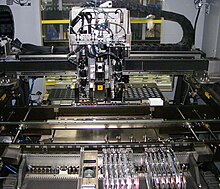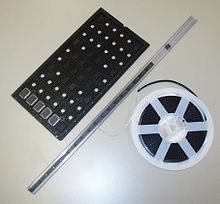Pick & place machine
A pick and place machine is a machine which in the manufacture of printed circuit boards to used devices to be placed on the circuit board after a soldering process are soldered. Pick and place machines have been around since the mid-1970s.
functionality
The individual components are made available to the placement machine in its component supply station ("feeder") in the following forms:
- Blister belts on rollers ("Tape & Reel") for most SMD components ,
- Trays with recesses ("Tray") for larger ICs ,
- for wired components as a belt ("Belt"),
- for larger components in plastic rods ("tubes").
A placement head, which can be moved in three axes and can rotate around the Z-axis, usually sucks a component out of the belt / tray by means of negative pressure, checks the position using a camera system, calculates the angular and position offset to the nominal position and places the component on the circuit board. Once all the components have been fitted, the circuit board is transported on via a conveyor system and a new empty circuit board is fed in.
To increase the throughput, modern machines work with multiple placement heads and "turret heads" that are able to accommodate multiple components, which reduces the travel time between the filling station and the circuit board. The circuit boards are usually in the form of a panel on which several similar, but also different layouts are combined on a large circuit board in a standard format, which are only separated later. This significantly reduces the transport time per circuit board and thus increases the throughput of a production line .
Modern automatic placement machines are similar in principle to a flatbed plotter , with the circuit board taking the place of the paper, the placement head that of the pen and the component supply that of the pen magazine. In older machines, the printed circuit board was often moved instead of the component, but this is more problematic when it is linked to the upstream and downstream process steps (paste printing, soldering).
Most of the assembly machines are designed to be modular so that different component supply stations, assembly heads, camera systems, etc. can be attached.


